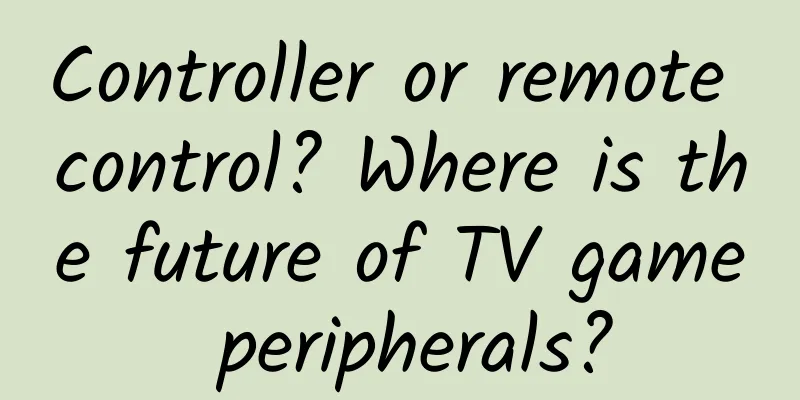Controller or remote control? Where is the future of TV game peripherals?

|
The booming development of TV games has also allowed many games to be displayed on the big screen of TV. However, with the continuous increase in the number of games, the content and gameplay of TV games have also become more diverse, so the types of gaming peripherals have also become more abundant. However, for TV games, the popularity of peripherals is not satisfactory. So which kind of peripherals is more suitable for the development of TV games? Can the lowest-cost mobile phones and remote controls stand on their own? At present, the remote control is the control device that comes with the TV. It has become the first choice for users to play TV games because of its low price and easy-to-understand operation. However, when users play games with their families, a remote control is often not enough. Therefore, with the emergence of various APPs, mobile phone peripherals have also come into being. As the two control devices with the lowest production costs, can mobile phones and remote controls hold up a place in TV games? For the remote control, simple operation and familiar buttons allow players to play games with ease. However, the standard remote controls for TVs of different brands are not the same. For example, some TV remote controls have as many as 20 buttons. Different standards mean that the games that can be operated are also very different. Simple casual games such as "Simi Mahjong" and "Bawang Biji" can be played by any remote controller. However, somatosensory games such as "Sports Plus" cannot be operated by other remote controllers except those equipped with somatosensory devices. For other games with slightly more complicated operations such as "Riptide Speedboat", there are even fewer that can be operated by remote controllers. Mobile phones with APP installed can produce different gaming peripheral effects according to the type of APP installed. For example, the Sports Plus APP can turn the mobile phone into a somatosensory device, and can also be turned sideways to become a handle, which is a universal control device. However, the operating feel of different mobile phone models also bothers players. As a touch-screen mobile phone, although it can act as an operating device on the mobile phone screen, touching the screen does not produce physical interaction, making it impossible for users to understand whether the operation is correct. APP software also has its own compatibility issues. For example, the iPhone uses the iOS system and cannot be compatible with the Android system APP. And some specific TV remote control APPs can only be used in designated mobile phones, otherwise the remote control will fail. Therefore, although mobile phones and remote controls can be used as gaming peripherals, they can only control some simple casual games due to problems such as inconsistent buttons, complex game operations, and incomplete APP adaptation. Can following traditional controllers become mainstream? Since Nintendo released the NES controller in 1984, the functions of the controller have been increasingly improved and gradually became the default operating device for console games. For the rapidly developing TV games, the influx of many games also brought the controller into the mix. However, on the big TV screen with many games, can the controller become a mainstream choice like console games? Among TV games, for casual games that can be played with a remote control, such as "How to Train Your Dragon" and "Never Say Die", the controller operation is no problem at all. And for challenging racing games such as "Riptide", the use of the controller also makes the game process more enjoyable. However, for smart TVs at this stage, video games are just one of the functions, so controllers are not necessary, and game manufacturers will not give away controllers as accessories for TVs like giving away remote controls. According to statistics, the popularity of controllers is far lower than that of remote controls, only about 3%. Except for game enthusiasts, ordinary users will not spend money on a controller that is not often used just to play a video game. In addition to cost factors, the composition and adaptation of games also reduce the popularity of controllers. According to statistics, 90% of TV games are ported games, and some games developed for touch-screen mobile phones are difficult to operate with controllers or even remote controls when ported to large-screen TVs. For common first-person shooter games, it is difficult to control the crosshairs with a controller. For example, the previously reviewed "Death Effect" was only ported and adapted, and the difficulty of the game was not changed, making the operation of the controller much more difficult on the basis of the difficulty of controlling the crosshairs. Therefore, at this stage, although controllers are considered to be the best choice for gaming peripherals, the popularity of controllers has always been a problem in terms of TV games, which may be an obstacle for controllers to become mainstream peripherals for TV games. Is there a future for VR? In the process of game development, various peripherals such as controllers and somatosensory devices have also allowed many players to experience different game fun. With the development of peripherals, VR or virtual reality technology has also begun to show its edge. For TV games, can VR meet people's expectations for virtual game peripherals? Since American Lanier proposed the concept of VR, virtual reality technology has continued to develop. With the advancement of technology, virtual reality has also emerged in many fields. After the appearance of the VR game "Summer Lesson" that attracted much attention from players at the Sony E3 conference in 2014, the perceptual immersive gameplay of VR in games has also been known to everyone. As TV games gradually develop, VR technology is also attracting the attention of developers, such as Toy Maker, the first game developed specifically for the Playroom DLC function of PlayStation 4 virtual reality game function. This game uses a smartphone or tablet as a second display to project the virtual pet created in PS4 into the real environment. The development of this game also makes VR technology closer to gamers. Many domestic TV game manufacturers have also shown great interest in VR technology. The emergence of virtual reality glasses such as the "Nibiru Dream Mirror" has also linked many virtual reality games to large-screen TVs, and at the same time indicates that VR technology is gradually entering the domestic TV game market. However, although many virtual reality technology products have been launched and are supported by software engines such as Unity and Unreal Engine, the development of VR technology has been hindered by issues such as the ownership of core technologies and the lack of companies with strong technology. At present, although there are many obstacles in the development of virtual reality technology, with the improvement of technology and the popularization of VR equipment, virtual technology will eventually allow peripherals to unleash unimaginable energy in TV games. What is the difficulty in developing TV game peripherals? First, from the user's perspective, cost is a factor that bothers users when choosing gaming peripherals. In addition to the extreme pursuit of gaming peripherals by game enthusiasts, if two peripherals can operate games, ordinary users will inevitably choose the cheaper one. Therefore, if the cost required for peripheral development at this stage is reduced, the chances of peripherals appearing in ordinary households may be greatly increased. Secondly, TVs are not like other electronic products, and gaming peripherals are not like remote controls, which are standard accessories for TVs. The degree of compatibility between gaming peripherals and TVs often affects the user's gaming experience. Whether it is a controller or a remote control, no peripheral product can truly be fully compatible with TV games. Increasing user choices and learning costs naturally hinders the popularization of gaming peripherals. Finally, the quality of the game content often affects the gaming experience that peripherals bring to players. For example, racing games can be operated with a handle, but a steering wheel that simulates racing operations may give players a more realistic feeling. Somatosensory games with somatosensory devices and shooting games with light guns are also excellent choices for players to be immersed in the game. Therefore, if the attractiveness of the game content is improved and many players are invited to join, the importance of peripherals will be more prominent. With the end of the GMIC meeting, the three major operators also proposed normative regulations for game controls, unifying issues such as the buttons of some gaming peripherals in TV games. Although at this stage, such a control test certification mechanism and the "Control Specification Document" may not be perfect, it undoubtedly allows many people to see the signs of TV game peripherals tending towards standardization. Games and peripherals have been interdependent and indispensable to each other since the emergence of games. For TV games in the early stages of development, how to make good peripherals is both a challenge and has brought more possibilities for the development of TV games. With the intervention of more standards and specifications, we have reason to believe that the entire industry is developing in a positive direction. As a winner of Toutiao's Qingyun Plan and Baijiahao's Bai+ Plan, the 2019 Baidu Digital Author of the Year, the Baijiahao's Most Popular Author in the Technology Field, the 2019 Sogou Technology and Culture Author, and the 2021 Baijiahao Quarterly Influential Creator, he has won many awards, including the 2013 Sohu Best Industry Media Person, the 2015 China New Media Entrepreneurship Competition Beijing Third Place, the 2015 Guangmang Experience Award, the 2015 China New Media Entrepreneurship Competition Finals Third Place, and the 2018 Baidu Dynamic Annual Powerful Celebrity. |
<<: Alibaba’s market value has evaporated significantly, so investors no longer love it?
>>: After running scores, generating fever, and being awesome, what is Lei Jun’s fourth move?
Recommend
Light Course 1.01 covers courses for all grades_Taoduoduo
【Software Description】 All grades can watch onlin...
Remembering Academician Yang Le: "We must write the names of Chinese people in mathematics books"
October 22, 2023 Academician of the Chinese Acade...
Why do hackers always pick on Sony?
WinBeta, a US technology information website, rec...
Microsoft: 7 reasons why you will love Win10
Although some major companies are missing from th...
Boss Dai from Fantong: "Yuanchuan Investment Academy"
Boss Fantong Dai: Introduction to the resources o...
It’s time to gather around the fire again. Have you fallen into these common misunderstandings about using charcoal?
Winter is here. Nowadays, heating has been turned...
“Tik Tok Likers” earn over 10,000 yuan a month, is it reliable?
"Making money from those who want to make mo...
How to learn English? Zhou Bangqin's "Follow Friends" 100 days to speak English easily
Training course content: In fact, most people wil...
Intellectual Academy "Intellectual Training Camp 2.0" fully upgrades your thinking ability
Intellectual Academy "Intellectual Training ...
How to use WeChat mini-programs to retain customers? What should I do if I quit using WeChat Mini Program?
Q: How to use WeChat Mini Program to retain custo...
Feeling down? Maybe your stomach is asking for help!
Recently, the topic of "Is the stomach reall...
From the Hooked user incentive model, a comprehensive analysis of why "Honor of Kings" makes you addicted?
Why is " Honor of Kings " so popular? W...
User operations, how to solve user pain points?
When considering user needs, we look at the produ...
Where does astronauts get water outside the earth?
There are three urine collection buckets in front...
Amazon Entry-level to Mastery Training Courses (26 sets)
A collection of Amazon introductory to proficient...









